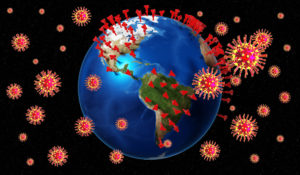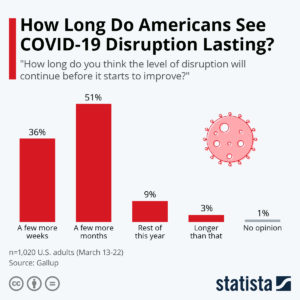“What you get is the initial damage and rush of inflammatory cells, but the damage is so extensive that the body’s immune response is completely overwhelmed — which causes even more immune response, more immune cells and more damage,” said Matthew Frieman, a virologist at the University of Maryland School of Medicine.
PMC U.S. National Library of Medicine/National Institutes of Health states, “Inflammation is a biological response of the immune system that can be triggered by a variety of factors, including pathogens, damaged cells and toxic compounds. These factors may induce acute and/or chronic inflammatory responses in the heart, pancreas, liver, kidney, lung, brain, intestinal tract and reproductive system, potentially leading to tissue damage or disease.
With infection, the virus probably begins to multiply inside cells lining the airway, which are fringed with hairlike structures. Coronaviruses that cause common colds are excellent at infecting the upper airway, while SARS tended to go deeper in the lungs. As the coronavirus gains strength, Frieman said, dead cells are sloughed off and collect in the airway, making breathing difficult.
Inflammation is the immune system’s response to harmful stimuli, such as pathogens, damaged cells, toxic compounds, or irradiation [1], and acts by removing injurious stimuli and initiating the healing process [2]. Inflammation is therefore a defense mechanism that is vital to health [3]. Usually, during acute inflammatory responses, cellular and molecular events and interactions efficiently minimize impending injury or infection. This mitigation process contributes to restoration of tissue homeostasis and resolution of the acute inflammation. However, uncontrolled acute inflammation may become chronic, contributing to a variety of chronic inflammatory diseases [4].
At the tissue level, inflammation is characterized by redness, swelling, heat, pain, and loss of tissue function, which result from local immune, vascular and inflammatory cell responses to infection or injury [5]. Important microcirculatory events that occur during the inflammatory process include vascular permeability changes, leukocyte recruitment and accumulation, and inflammatory mediator release [2, 6].
Various pathogenic factors, such as infection, tissue injury, or cardiac infarction, can induce inflammation by causing tissue damage. The etiologies of inflammation can be infectious or non-infectious (Table (Table1).1). In response to tissue injury, the body initiates a chemical signaling cascade that stimulates responses aimed at healing affected tissues. These signals activate leukocyte chemotaxis from the general circulation to sites of damage. These activated leukocytes produce cytokines that induce inflammatory responses [7].
The inflammatory response is the coordinate activation of signaling pathways that regulate inflammatory mediator levels in resident tissue cells and inflammatory cells recruited from the blood [8]. Inflammation is a common pathogenesis of many chronic diseases, including cardiovascular and bowel diseases, diabetes, arthritis, and cancer [9]. Although inflammatory response processes depend on the precise nature of the initial stimulus and its location in the body, they all share a common mechanism, which can be summarized as follows: 1) cell surface pattern receptors recognize detrimental stimuli; 2) inflammatory pathways are activated; 3) inflammatory markers are released; and 4) inflammatory cells are recruited.”
This is why you see constant commercials stating to stay home especially if you have HEALTH RISK FACTORS like lung disease, diabetes, low immunity, and heart disease/high B/P. Including obesity. that put you at highier risk in getting or fighting off COVID-19. The homeless and the older age (60 years old and up) to find it harder to fight off especially with disease present. It’s like a car in that the longer you have the car the more wear and tear on the car well the same with the body for elderly and homeless. The older the patient the harder it is to fight the disease. So there are factors that involve bad turn outs for patients with Covid-19 virus that can go to lung damage to death.
Through worldometer.info as of this past Weekend 976,176 cases of corona virus in the USA. Close to one million cases and where is the worst cases NY being in NYC and NJ (there next door neighbor). NY cases are 293,354 with total deaths 22,275
Through nyc.gov in NYC Total cases are 153,204, Hospitalized cases are 39, 635 Confirmed Deaths 11,460 Probable Deaths 5213
Why was NYC over 1/2 the cases in America at points during this covid epidemic. You need to look at the environmental risk factors with the pt’s health status that all play roles with all diseases or infections to fight off.
Size of NYC – of the 5 bureau cities only covers 321 square miles, over 205,000 acres.
Population The population of people in NYC are 8.399 million not including illegals .
One of the Dirtiest City in America – NYC (within the top 10) who has the highest count of Corona Virus in America.
The top five cities in the US by population density (in order) were New York City, San Francisco, Boston, Miami, and Chicago — but the dirtiest cities (in order) were:
- New York City
- Los Angeles
- TIE: Chicago (for litter), Houston (for pests)
- TIE: Philadelphia (for litter), Miami (for pests)
- TIE: San Francisco (for litter), Atlanta (for pests)
Resource: apartment therapy (apartmenttherapy.com)
“This is the harsh, lung-searing, rash-inducing reality for millions of people in some of America’s biggest cities. Is your town on the list? (Pictured is the Gowanus Canal Superfund site in Brooklyn, New York.) For an explanation of how the rankings were done, click on the article link above.”
Resource: FORBES
Sanctuary City – Acknowledging both sides of the issue, Leaders of sanctuary cities say they want to reduce fear of deportation and possible family break-up among people who are in the city illegally, but the otherside is this can definitely put a city at a potential risk for disease. Why? they live in low economical environment, for the majority.
Low income groups in the city. This means that in New York City income of $68,720 for a family of four is considered to be low income. (Resource: https://www.povertycenter.columbia.edu/poverty-disadvantage-in-new-york-city). Putting the math together these families are not living in Pent houses or a house but a small apt. for the majority and in a poor economic area unfortunately.
About 1.7 million New Yorkers lived below the poverty line in 2011-2015. This number is larger than the population of Philadelphia or Phoenix, and would be the country’s 7th largest city if ranked separately. The overall poverty rate in New York City has remained relatively steady since 1980, hovering at around 20%. Living in a poverty line effects health anywhere especially over a million people. You have homeless in the streets.
Homes – primarily apartments and small. Since the cities started with buildings and this was primarily the homes and in most cities. which is the case.
Subways & Buses – a major way of transportation in NYC. Standing right next to each other made it easier to catch COVID19. Your not living in a area of transportation that isn’t driving by yourself or 6 feet apart from each other on average and in general your on top of each other during work hours in buses on subways.
Two international airports – J.F.K. and La Guardia. Traveling in and out of America all over the world including China. Airports are in the top 10 areas to easily pickup infections.
Pollution in NYC – in 1oth place the worst pollution by Yahoo Finance (the 7 of the 9 before it where all in California). By Environment & Science blog it states NYC is #10 (https://www.scpr.org). New York-Newark-Jersey City, NY-NJ-PA is documented as one of the worst air pollution areas in America by USA Today. Must I go on.
See the pattern why NYC is highest with Covid19 virus?
There are numerous factors putting NYC at risk for where they are in count of Covid19 unfortunately and Governor Cuomo also pointed out this past Monday . “we need to learn and act on this pandemic to be better prepared for the next one.” and he gave examples in American history has gone through disasters before from Great Chicago Fire, Depression, and others which made our nation stronger.
Know this America had worse pandemics and we got through them and we will with this pandemic Corona Virus!

